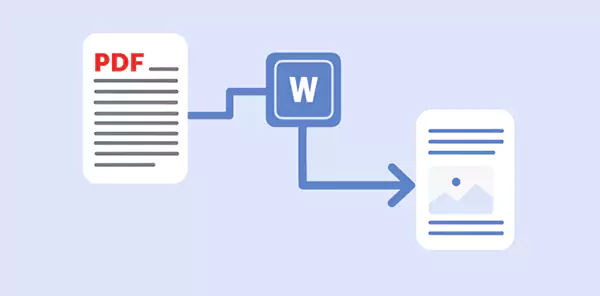
Welcome to the ultimate guide on converting PDF to Word! If you’re a student, professional, or someone who frequently deals with documents, chances are you’ve encountered the need to switch a Portable Document Format file into an editable Word format.
But why is this conversion necessary? And what methods can you use to achieve it? Don’t worry – we’ve got all the answers right here! In this comprehensive blog post, we’ll delve into the differences between PDF and Word formats, and explore various reasons why you might need to convert them.
We’ll also discuss different methods for conversion along with their pros and cons, and provide tips for successful conversions. And, try to troubleshoot common issues that may arise during the process, and recommend some of the best software and tools available for seamless conversions.
So if you’re ready to unlock the full potential of your portable format files by transforming them into versatile Word documents, let’s dive in and discover everything you need to know about changing PDFs to Word!
Understanding the Differences Between PDF and Word Formats
Understanding the differences between PDF and Word formats is important. It is also imperative to recognize their distinct characteristics. PDF, short for Portable Document Format, is a file format that preserves the layout and formatting of a document regardless of the operating system or software used to view it. This makes them ideal for sharing documents while ensuring they appear exactly as intended.
On the other hand, Word documents are created using Microsoft Word or similar word processing programs. They allow users to edit and customize text, images, tables, and more. Unlike PDFs, which maintain their original arranging across different platforms, these files may look slightly different depending on the software or version being used.
Why Would You Need to Convert a PDF to Word?
There are several reasons why you might find yourself needing to convert pdf to word document. One common scenario is when you receive a portable document file that needs editing or modification. Unlike them, which are typically read-only documents, Word files offer the flexibility to make changes easily.
Another reason for turning them in is compatibility. Some software applications may not support viewing or editing PDF docs, but almost everyone has access to Microsoft tools. By converting the file format, you ensure that others can work with and view your document without any issues.
Methods for Converting PDF to Word

(This graph shows the Microsoft Workspace Tools users by age, in percentage).
In changing a file, there are numerous methods you can use. Each method has its own pros and cons, so it’s important to choose the one that best suits your needs.
One common method is using online conversion tools. These tools allow you to upload your PDF file and convert it into a Word document within minutes. They are convenient and easy to use, requiring no additional software installation. However, keep in mind that some online tools may have limitations on doc size or require an internet connection.
Tips for a Successful Conversion
- Select the Right Conversion Method: There are various methods available for transformation, such as online tools, desktop software, and even manual copy-pasting. Consider your needs and select the method that suits you best.
- Check Formatting: Portable files often have complex arranging like tables, images, and special fonts. Before conversion, ensure that the converted document retains these elements correctly.
- Use OCR if Needed: If it contains scanned images or non-editable text, Optical Character Recognition (OCR) technology can help switch them into editable text in Word.
- Review Converted Document: After the changeover, thoroughly review the converted Word document to check for any errors or missing content. Pay attention to formatting issues and make necessary adjustments.
Common Issues and How to Troubleshoot Them
- Formatting Errors: One common issue when converting PDF to Word is formatting errors. This can include changes in font styles, sizes, or spacing. To troubleshoot this, try adjusting the settings of your tool to preserve data formatting. You can also manually correct any arranging issues after the conversion.
- Images Not Converting Properly: Sometimes, images in a PD doc may not turn accurately into a document. To resolve this issue, check if your converter supports image extraction and select an option that ensures a high-quality image.
- Text Discrepancies: Another challenge is when the converted file contains incorrect or missing text compared to the original file. In such cases, it’s decisive to double-check both versions for accuracy and consider using alternative conversion methods for better results.
- Large File Size: Changing a large file might result in a significantly larger file size than expected due to the different compression algorithms used by each format. If you encounter this problem, try reducing the doc size before converting or use online tools specifically designed for compressing documents.
Best Software and Tools for Converting PDF to Word
To convert PDF files to Word documents, there are several software options available that can make the process quick and easy. Here are some of the best tools you can use:
- Adobe Acrobat: This is one of the most popular choices for converting PDFs. It offers a user-friendly interface and allows for accurate conversion with minimal formatting issues.
- Smallpdf: Known for its simplicity and efficiency, it is an online tool that allows you to switch your PDFs to editable Word documents in just a few clicks. It also offers additional features such as merging, compressing, and editing them.
- Nitro Pro: With its powerful OCR (Optical Character Recognition) technology, Nitro Pro ensures high-quality transformations while preserving the original layout and formatting of your documents.
- WPS Office: Not only does WPS Office offer a free office suite similar to Microsoft Office, but it also includes a robust converter that can handle both simple and complex conversions.
- Google Docs: If you prefer working with cloud-based tools, Google Docs is an excellent option. It allows you to upload your files and change them effortlessly.
Do You Know?
By 2025, the global Microsoft Office 365 services market is expected to reach $126.9 billion.
Conclusion
In this ultimate guide, we have explored the various aspects of switching from PDF to Word. We began by understanding the differences between these two doc formats and delved into why you might need to convert a PDF to Word in the first place.